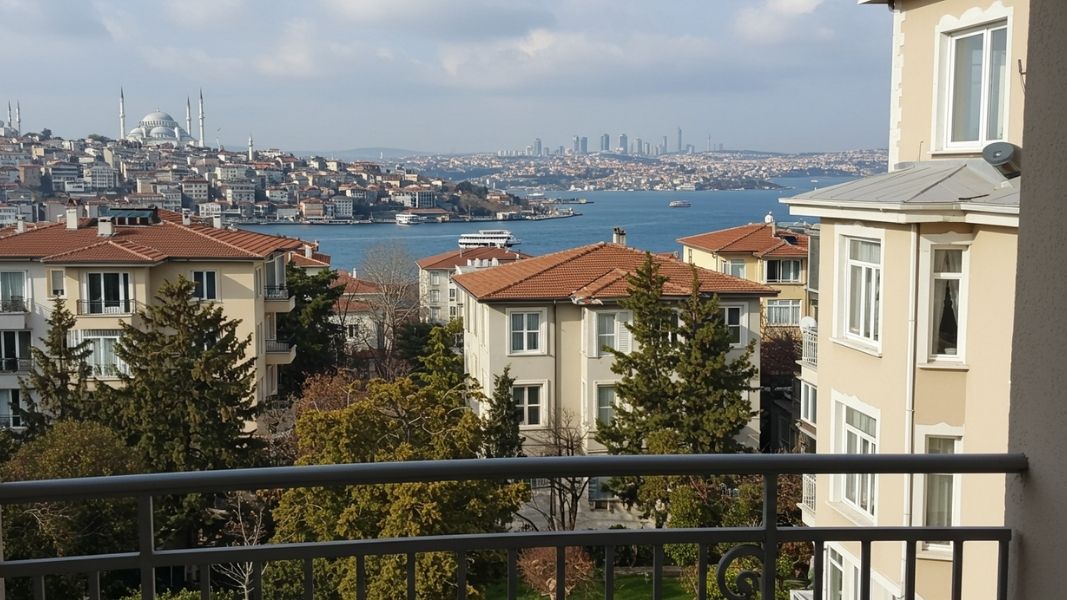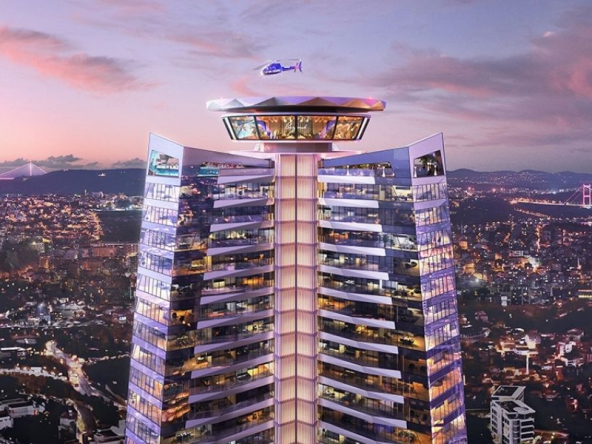Istanbul Home Prices – Prestigious Projects
As of 2025, housing prices in Istanbul continue to rise. Thanks to urban transformation, infrastructure projects such as the metro, and foreign investor interest, rental and sale prices are rapidly increasing in many areas. In this article, you will find comprehensive information about the Istanbul housing market that both investors and home buyers are paying attention to, including up-to-date prices by district, differences between new and second-hand properties, popular investment areas, price changes over the last year, supply and demand, popular apartment types, and average rental yields.
Daha Fazlası
Current Housing Prices by District
 Housing prices in Istanbul vary significantly from district to district. According to Hepsiemlak data for August 2025, the average price per square meter of apartments for sale across the city is around 58,940 TL. The most expensive districts are Beşiktaş, Kadıköy, and Sarıyer, while the most affordable ones are Esenyurt, Sultangazi, and Esenler. For example:
Most valuable districts (TL/m²): Beşiktaş ~166,667 TL, Kadıköy ~143,312 TL, Sarıyer ~136,111 TL. In these neighborhoods (Levazım, Harbiye, Nişantaşı, Etiler, Bebek, etc.), luxury housing projects reach over 200,000+ TL/m².
Most affordable districts (TL/m²): Esenyurt ~26,000 TL, Sultangazi ~35,346 TL, Esenler ~36,000 TL. In suburban areas (Silivri, Arnavutköy, Sultanbeyli, etc.), levels of 21,000–29,000 TL/m² can still be found. These regions remain below Istanbul’s average price levels.
Housing prices in Istanbul vary significantly from district to district. According to Hepsiemlak data for August 2025, the average price per square meter of apartments for sale across the city is around 58,940 TL. The most expensive districts are Beşiktaş, Kadıköy, and Sarıyer, while the most affordable ones are Esenyurt, Sultangazi, and Esenler. For example:
Most valuable districts (TL/m²): Beşiktaş ~166,667 TL, Kadıköy ~143,312 TL, Sarıyer ~136,111 TL. In these neighborhoods (Levazım, Harbiye, Nişantaşı, Etiler, Bebek, etc.), luxury housing projects reach over 200,000+ TL/m².
Most affordable districts (TL/m²): Esenyurt ~26,000 TL, Sultangazi ~35,346 TL, Esenler ~36,000 TL. In suburban areas (Silivri, Arnavutköy, Sultanbeyli, etc.), levels of 21,000–29,000 TL/m² can still be found. These regions remain below Istanbul’s average price levels.
| District | Average Sale Price (TL/m²) |
|---|---|
| Beşiktaş | 166,667 |
| Kadıköy | 143,312 |
| Sarıyer | 136,111 |
| Esenyurt | 26,000 |
| Sultangazi | 35,346 |
| Esenler | 36,000 |
New vs. Second-Hand Housing Prices
In 2024–2025, homebuyers often asked whether to prefer new (brand-new) or second-hand housing. Due to the scarcity of new projects in 2024, caused by high construction costs and interest rates, buyers shifted towards second-hand properties. Demand moved to the second-hand market; however, as second-hand prices also rose, the gap between new and old narrowed. Overall, in Istanbul, branded new housing projects sell about 10–20% higher than second-hand apartments. But the common view is that the decline in new sales in 2024 boosted interest in the second-hand market. Therefore: Price Comparison: New housing projects in city centers are more expensive. For example, in Beşiktaş or Kadıköy, 2025 delivery residence projects are priced around 150,000–200,000 TL/m², while older buildings in the same neighborhoods can range between 120,000–150,000 TL/m². Demand Trend: Due to loan conditions and construction costs, many buyers in 2024 turned to second-hand options with limited budgets. This created upward pressure on overall prices. Investor Preference: For investors, older homes in high-rental-potential areas are often preferred because new projects require higher down payments and stricter payment plans, while existing properties allow more flexible cash flow. In short, with low supply, competition increased in the second-hand housing market. In the future, low-interest campaigns or new project launches may change this balance.Popular and Rising Investment Areas
Where should investors and homebuyers focus in Istanbul? Especially transportation projects, strong rental demand, and urban transformation have become attractive. Key areas in 2025 include: Central and Luxury Neighborhoods: Beşiktaş, Şişli (Nişantaşı, Bomonti), Kadıköy (especially Bağdat Avenue), and Sarıyer (Maslak, Vadistanbul) are prestigious areas with very high housing values. For example, in Şişli Bomonti, new projects already exceed 100,000 TL/m². These districts are considered safe long-term investments. Renewed Mid-Segment: Kağıthane, Gaziosmanpaşa, Sancaktepe, Bayrampaşa have rapidly gained value in 2023–24 due to metro expansion, urban transformation, and new projects. For example, prices in Pendik have increased by 490% over the past 5 years (ranging from 15,000–24,000 TL/m²), while Esenyurt’s average rose to 19,000 TL/m² and Avcılar’s to 23,000 TL/m². Developing New Areas: Başakşehir, Beylikdüzü, Pendik/Tuzla corridor (e.g., Kurtköy), Arnavutköy (new settlement areas like Kayabaşı), Çekmeköy, and Ümraniye are promising investment areas. According to Deal-Tr analyses, Esenyurt, Beylikdüzü, and Başakşehir stand out for medium-to-long-term investment, while Kadıköy and Şişli remain prestigious living areas. Additionally, value increases are expected around newly opened metro lines (Bostancı-Pendik line, Kabataş-Mahmutbey metro, etc.). Emerging Distant Areas: Silivri, Çatalca, Şile, Sultanbeyli, and Arnavutköy, though farther from the city center, are gaining attention due to large projects and Kanal Istanbul planning. Prices are still more affordable here, offering long-term investors significant future gains. Important Note: When choosing an investment area, factors such as transportation, infrastructure, and social amenities are as important as current price levels. Each district has its own risks and opportunities.Housing Price Changes Over the Last Year
In 2024–2025, housing prices in Istanbul continued to rise. According to the CBRT HPI data, as of August 2025, housing prices in Istanbul increased by 30.2% annually. This strong growth averaged around 3% monthly. TÜGEM reported that in the first quarter of 2025, annual price growth in Istanbul was around 15% (compared to the first half of 2024). Inflation Effect: Even when adjusted for inflation, housing prices in Istanbul remain on an upward trend. Industry sources predict that due to high costs and credit conditions, this upward trajectory will continue throughout 2025. Rental Prices: Rental listings are also climbing. Especially in central and accessible districts, rents have risen by up to 200% in the past 2 years. The shift from buying to renting and lack of supply are driving rental increases. Hürriyet Emlak also reports that rising rents are pressuring housing demand. Sales Volume: In July 2025, home sales increased by 12.4% compared to the same month last year (142,858 units). Mortgage sales also rose. This indicates active demand, though high loan rates may limit growth. Overall, in the past year, both sales and rental prices in Istanbul continued to grow at double-digit rates. While this pace may slow somewhat in the near term, the upward trend is expected to continue.Supply-Demand Balance and Future Outlook
In 2024, the supply-demand balance was the main driver of housing prices. Key points include: Insufficient Supply: In 2024, new housing production struggled to meet demand. Rising construction costs, material supply issues, and currency fluctuations slowed projects, while population growth and urban migration kept demand strong. This pushed prices up rapidly. Persistent Demand: The demand for homeownership in Turkey remains high. For 2025, demand for housing is expected to continue rising. Urban transformation projects and social housing initiatives support this demand. Interest from foreign investors also boosts overall demand in Istanbul. Future Expectations: Experts forecast continued price increases in 2025. Especially in major cities, limited supply against strong demand keeps both prices and rents climbing. However, high loan costs and economic policies could partially slow this growth. Demand depends heavily on financing conditions (such as low-interest loans), making these regulations key to future prices. Note: Data-driven planning is critical. Industry representatives emphasize that more social housing, accessible credit options, and land incentives could help ease demand and price growth in the short term.Most Demanded Apartment Types
In Istanbul, most buyers and tenants prefer 1+1, 2+1, and 3+1 apartments. Young professionals and small families prefer 1+1 and 2+1, while medium-sized families prefer 2+1 and 3+1. Based on real estate listings, the average sales prices in Istanbul by type are:- 1+1 apartment: Average ~4,397,000 TL
- 2+1 apartment: Average ~5,271,000 TL
- 3+1 apartment: Average ~7,999,000 TL



